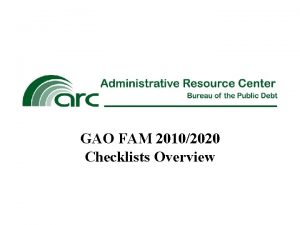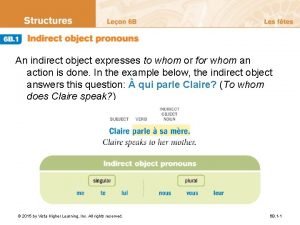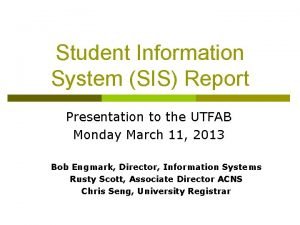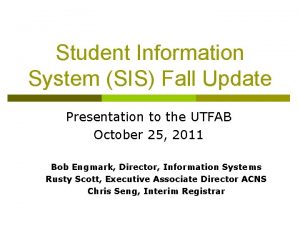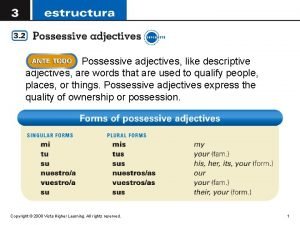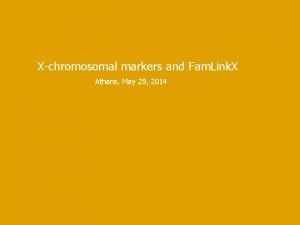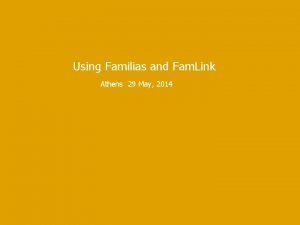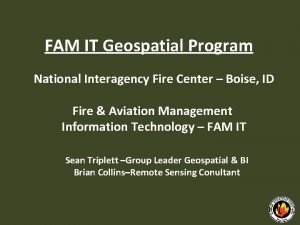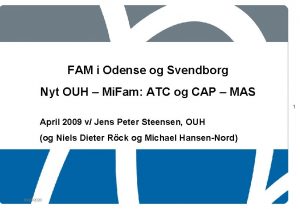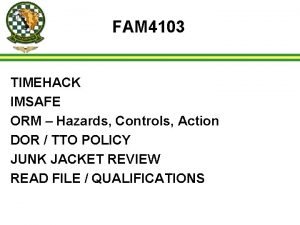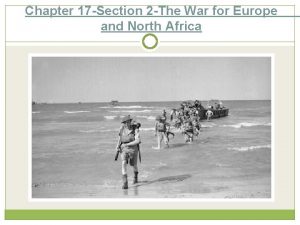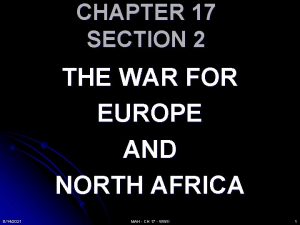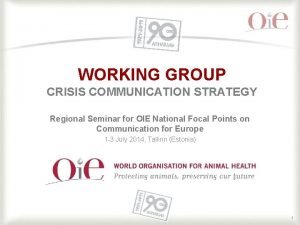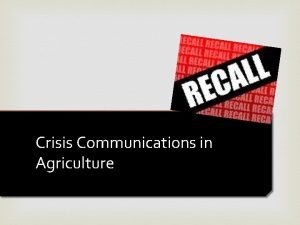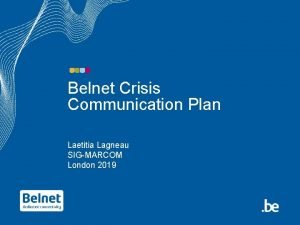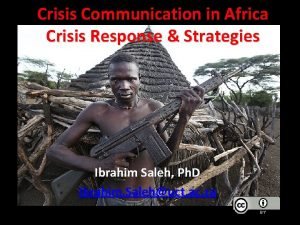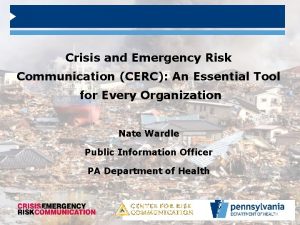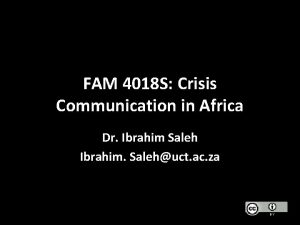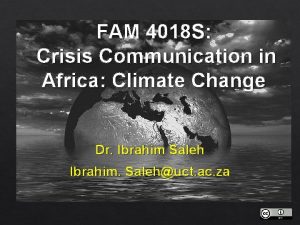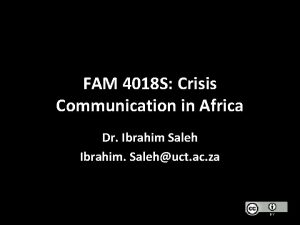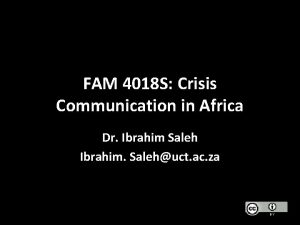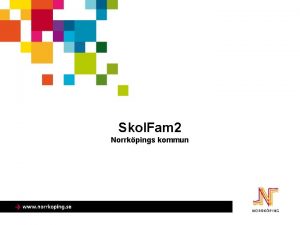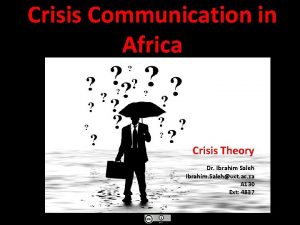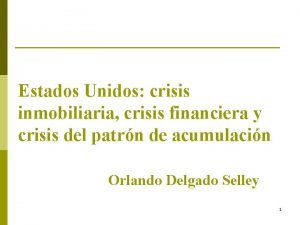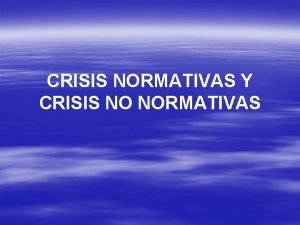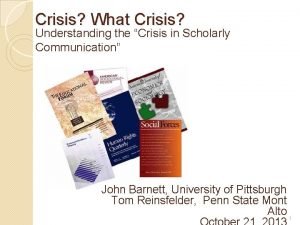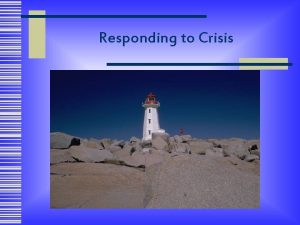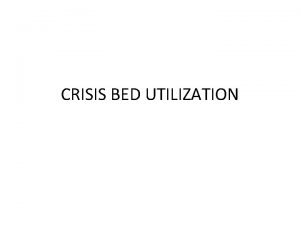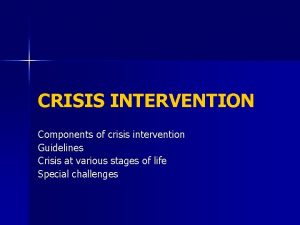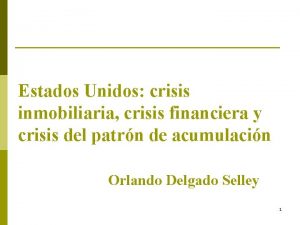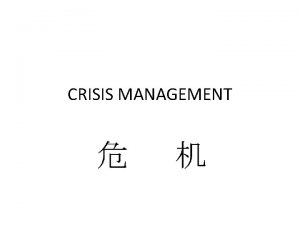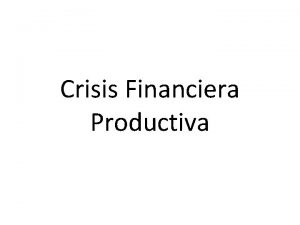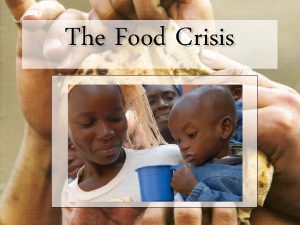FAM 4018 S Crisis Communication in Africa WAR

































- Slides: 33

FAM 4018 S: Crisis Communication in Africa WAR & CONFLICT Dr. Ibrahim Saleh Ibrahim. Saleh@uct. ac. za

Conflict is a condition that exists anytime two or more people disagree. It is a natural phenomenon, neither inherently good or bad, but there may be positive or negative outcomes.


Structural factors, including economic, social, and political issues relating to wealth distribution, facilitating factors, including the degree of politicization and consciousness, and triggering factors, such as a sharp economic shock, sudden escalation of inter-group tension or the collapse of central authority, are generally argued to be the main causes of conflicts (Costy & Gilbert 1998: 12). The media in conflict-ridden countries often play a significant role in creating and furthering both facilitating factors and triggering factors, for example by utilising ' oppositional metaphors' (' us ' vs. ' them ') linked to internal and external issues or ‘threats’ facing the nation (see Jager & Link 1993; Van Dijk 1997).

Conflict Resolution General perceptions of conflict as "negative: " Anger Disagreement Hostility Threat Anxiety Competition Tension Violence Destruction Pain War 5

Conflict Resolution Potential Productive Outcomes of Conflict: Strengthening Creative Helpful Enriching Clarifying Learning Stimulating Intimate Caring Courageous Opportunity Inclusive 6

Conflict Resolution Managing conflict in a dysfunctional way is a learned behavior and can be changed. 7

Conflict Resolution How do/did we learn our own styles of conflict management? Role Models? Family role models Celebrity role models Teachers/mentors/coaches Media examples/role models 8

Personal Styles of Dealing with Conflict Turtle (Avoidance) Teddy Bear (Accommodation) Shark (Domination) Fox (Compromise) Owl (Integration) 9

Conflict Resolution It’s likely that a person employs more than one style, depending on the situation, but usually one style dominates. Certain styles may be appropriate for certain situations. 10

Conflict Resolution Managing conflict constructively depends in large measure on clear, open, and honest communication 11

Preventing communications blackouts (Smith & Simpson, 2009) Communication technologies are effective community response to disasters. And the lack of communications directly contributes to low levels of awareness for emergency responders. When all channels of communication are down, effective community disaster response is greatly diminished. Establishing and maintaining lines of direct contact between emergency managers, decision makers, formal and informal responders, government officials, and the public are primary objectives in emergency planning and responding. A continuing re-evaluation of methods for providing emergency communications is both critical and necessary for lessening the impacts of future disasters and improving urban resiliency.

Van de Walle and Turoff note that "the faster emergency responders are able to collect, analyze, disseminate, and act on key information, the more effective and timely will be their response, the better needs will be met, and the greater the benefit to the affected populations. " In improving the speed of information exchange it could be necessary to rapidly deploy advanced communications technologies at multiple locations near and around the incident area. An on-scene communications center provides obvious advantages for directing sensitive and often dangerous response operations because of the heightened situational awareness of the center’s personnel.

Elements of Communication Source - Person that begins or initiates message Message - Information or the meaning Channel - Medium through which message is transmitted Receiver - Person who is targeted for the message 14





Conflict Resolution Skills Getting the facts Active/Reflective Listening Defusing/managing anger Empathy skills Cognitive restructuring Negotiating outcomes 19

Conflict Resolution Process Find a good time and place to talk. Discuss the problem - Clarify issues Get all the facts Use active (aka reflective) listening Use "I" messages Focus on the problem, not the person Avoid communication blockers 20

Conflict Resolution Process Generate a variety of options; brainstorm Choose a solution that works for almost everybody Try the solution. If it doesn’t work, go back to step three and renegotiate. 21

Active Listening Look at the person speaking Maintain an open mind Pay attention Ask questions Repeat what the speaker says Listen for the feelings of the speaker Don’t: Interrupt, change the subject, make up your mind before the person finishes speaking 22

Roadblocks To Resolving Conflict Clashing Egos - Styles Of Conflicts Name calling Sarcasm/Ridicule Insulting Threatening Blaming Inflexibility Defensive body posturing/language 23

“No-Lose Method” Steps To Follow: 1. Defining the problem in terms of needs. 2. Generating possible solutions (brainstorming). 3. Evaluating and testing the various solutions. 4. Deciding on mutually acceptable solutions. 5. Implementing the solution. (Try it out. ) 6. Evaluating the solution. 24

"No-Lose Method" Some Assumptions about the No-Lose Method: Your needs are important My needs are equally important We will approach this conflict from a needs standpoint, not a solution standpoint. I will never use my power. 25

Methods of Conflict Resolution - Behjat Sharif Denial Suppression Power Compromise Collaboration 26

Images of wars Images of war, like photographic records of other dramatic crises and events, are often treated as spontaneous, powerful and authentic depictions of real events and real human experience. Images of war connect the viewer of the image with the depicted encounter and emotional experience of the individual photographer/reporter/artist who confronted the scene. Audiences treat images as primarily the products of individual photographers, as the records of their particular encounters and life experiences, and try to explain them by learning more about the photographer’s life – his or her motivations, intentions, temperament, approach to work and the details of the encounters and interactions that appear in his or her pictures.

Images of War and conflict Photographic images of war have been used to accentuate and lend authority to war reporting (Griffin, 2010). Media representations of war are of interest to media scholars for many reasons: First, as reports or images associated with extreme conflict and matters of life and death, they tend to draw intense public attention, and potentially influence public opinion. Second, as high-stakes artifacts of modern news reporting, they highlight the application of professional norms and practices to the presentation of highly charged content. Notions of objectivity and balance, reliance on official sources and press releases, access to theaters of action, collaborations with subjects and beliefs in photorealism and documentary recording are all issues that are tested by the results of wartime reporting and image-making. Third, they inevitably reflect cultural perspectives and reproduce traditions of cultural representation.

(1997) comments: In war photography … responses are magnified. Danger hovers at the edges of all such images; the passions they record are always the most extreme. The possibility of dying that is their subtext, for their subjects as much as the photographer, means they make urgent claims on our attention, allowing us both to feel a sense of our own mortality and to hold that sense at bay. The forcefulness of their messages makes them unlike any other genre of image, the power of their desire to communicate impelling them towards representations that touch us more deeply and more directly. (p. xi)

The technical and psychological readiness to photograph the war is determined by the warring nations to control and use the media to their own advantage. Despite the new capacity for extensive photo recording, it is always a highly censored war, and public commitment to the war effort on all sides meant that government control largely went unchallenged. This makes the gap between the millions of war images created and the relatively few selected for publication and public exposure was enormous. This ongoing mediation of public life can be explicated both by examining how the photograph’s artistry shapes moral judgment and by tracking subsequent narrative reconstructions and visual appropriations of the image in public media. (pp. 174– 5)



This presentation is licenced under the Creative Commons Attribution 2. 5 South Africa License. To view a copy of this licence, visit http: //creativecommons. org/licenses/by-sa/2. 5/za/ Or send a letter to Creative Commons, 171 Second Street, Suite 300, San Francisco, California 94105, USA.
 Acetylcholine crisis
Acetylcholine crisis Sensitive but unclassified
Sensitive but unclassified![(you [fam., sing.] dropped) las pastillas. (you [fam., sing.] dropped) las pastillas.](data:image/svg+xml,%3Csvg%20xmlns=%22http://www.w3.org/2000/svg%22%20viewBox=%220%200%20200%20200%22%3E%3C/svg%3E) (you [fam., sing.] dropped) las pastillas.
(you [fam., sing.] dropped) las pastillas.![(you [form., sing.] left) aquí la radiografía. (you [form., sing.] left) aquí la radiografía.](data:image/svg+xml,%3Csvg%20xmlns=%22http://www.w3.org/2000/svg%22%20viewBox=%220%200%20200%20200%22%3E%3C/svg%3E) (you [form., sing.] left) aquí la radiografía.
(you [form., sing.] left) aquí la radiografía. It audit manual volume 3
It audit manual volume 3 Gerstmann syndrome mnemonic
Gerstmann syndrome mnemonic Indirect object pronouns continued
Indirect object pronouns continued Famweb csu
Famweb csu Csu famweb
Csu famweb (their) nietos son japoneses.
(their) nietos son japoneses. Think family ni
Think family ni Fire family plus
Fire family plus Fam link
Fam link The link athens
The link athens Gabriele wienhausen
Gabriele wienhausen Fam it
Fam it Fam svendborg
Fam svendborg Pmu fam items
Pmu fam items Fam iplik
Fam iplik The war for europe and north africa chapter 17 section 2
The war for europe and north africa chapter 17 section 2 The war for europe and north africa chapter 17 section 2
The war for europe and north africa chapter 17 section 2 Crisis communication working group
Crisis communication working group Crisis communications lecture
Crisis communications lecture Communicaiton plan
Communicaiton plan Crisis communication skills
Crisis communication skills Crisis communication model
Crisis communication model Crisis and emergency risk communication
Crisis and emergency risk communication War at home vs war abroad madison
War at home vs war abroad madison Korean war vietnam war venn diagram
Korean war vietnam war venn diagram The cold war lesson 1 the cold war begins
The cold war lesson 1 the cold war begins Comparing reconstruction plans venn diagram
Comparing reconstruction plans venn diagram Was john bradford pro war or anti war
Was john bradford pro war or anti war Ich war du warst
Ich war du warst Force and motion study jams
Force and motion study jams

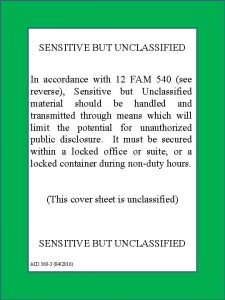
![(you [fam., sing.] dropped) las pastillas. (you [fam., sing.] dropped) las pastillas.](https://slidetodoc.com/wp-content/uploads/2021/02/3948728_11eb52afea26754ab90a65e7c62f281d-300x225.jpg)
![(you [form., sing.] left) aquí la radiografía. (you [form., sing.] left) aquí la radiografía.](https://slidetodoc.com/wp-content/uploads/2020/12/2869291_b74ccaebd8876676efceeaa1f1a8fa04-300x225.jpg)
